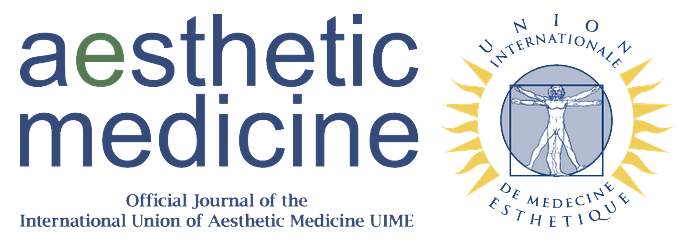Study of the effect of the combined drug PN and HA on the regeneration of collagen fibers of the skin in an experiment
Keywords:
Polynucleotide, hyaluronic acid, PDRN, twacAbstract
The scientifically justified use of drugs containing polydeoxyribonucleotide (PDRN) to stimulate various regeneration links has been confirmed by repeated publications in the medical literature. The demand for healing medicines in all areas of medicine makes it urgent to search for new effective drugs and their combinations to improve regeneration. The pharmacobiological properties of PDRN and hyaluronic acid (HA) make it clear that in combination these drugs will synergistically stimulate skin healing. However, there is no information about the study of the therapeutic effect of the PDRN/HA combination on the healing of skin wounds yet. In this work, the process of regeneration of collagen fibers (CF) of the skin under the influence of this combination in the preparation TwAc 2.0 was studied on an experimental model of a scalped wound in 17 white mongrel rats. When analyzing the results obtained: macro and microscopic parameters, morphometric parameters of collagen fibers in the field of regeneration, the dynamics of the restoration of the CF of the skin was evaluated and compared in two groups: the study group, where the combined drug PDRN/HA was used, and in the comparison group, where 0.9% NaCl solution was used. Earlier epithelialization of the wound and maturation of the CF, the normotrophic nature of scarring in PDRN/HA group indicates more favorable conditions for regeneration under the influence of the combined drug PDRN/HA.
References
Noh TK, Chung BY, Kim SY, et al. Novel Anti-melanogenesis properties of polydeoxyribonucleotide, a popular wound healing booster. Int J Mol Sci. 2016; 17(9):1448.
Emanuel CF, Chaikoff IL. The large scale preparation of sodium desoxyribonucleate from ripe salmon testes. J Biol Chem. 1953; 203(1):167-71.
Rigano L, Andolfatto C, Rastrelli F. Antiaging effects of a skin repair active principle. Cosmetics Toiletries. 2006; 121(11):57-64.
Galeano M, Bitto A, Altavilla D, et al. Polydeoxyribonucleotide stimulates angiogenesis and wound healing in the genetically diabetic mouse. Wound Repair Regen. 2008; 16(2):208-17.
Guizzardi S, Galli C, Govoni P, et al. Polydeoxyribonucleotide (PN) promotes human osteoblast proliferation: a new proposal for bone tissue repair. Life Sci. 2003; 73(15):1973-83.
Stefano Guizzardi, Jacopo Uggeri, Silvana Belletti, Giulia Cattarini. Hyaluronate Increases Polynucleotides Effect on Human Cultured Fibroblasts. Journal of Cosmetics, Dermatological Sciences and Applications. 2013; 3:124-128.
Jacobson KA, Gao ZG. Adenosine receptors as therapeutic targets. Nat Rev Drug Discov. 2006; 5(3):247-64.
Cronstein BN. Adenosine, an endogenous anti-inflammatory agent. J Appl Physiol (1985). 1994; 76(1):5-13.
Squadrito F, Bitto A, Altavilla D, et al. The effect of PDRN, an adenosine receptor A2A agonist, on the healing of chronic diabetic foot ulcers: results of a clinical trial. J Clin Endocrinol Metab. 2014; 99(5):E746-53.
Sini P, Denti A, Cattarini G, Daglio M, Tira ME, Balduini C. Effect of polydeoxyribonucleotides on human fibroblasts in primary culture. Cell Biochem Funct. 1999; 17(2):107-14.
Zhong H, Belardinelli L, Maa T, Zeng D. Synergy between A2B adenosine receptors and hypoxia in activating human lung fibroblasts. Am J Respir Cell Mol Biol. 2005; 32(1):2-8.
Chan ES, Fernandez P, Merchant AA, et al. Adenosine A2A receptors in diffuse dermal fibrosis: pathogenic role in human dermal fibroblasts and in a murine model of scleroderma. Arthritis Rheum. 2006; 54(8):2632-42.
Bitto A, Minatoli L, Polito F, Altavilla D, Cattarini G, Squadrito F. Polydeoxyribonucleotide improve angiogenesis and wound healing in experimental burn wounds. In: 8th International Symposium on Adenosine and Adenine Nucleotides. Ferrara, Italy: Springer; 2006. p. 14.
Polito F, Bitto A, Galeano M, et al. Polydeoxyribonucleotide restores blood flow in an experimental model of ischemic skin flaps. J Vasc Surg. 2012; 55(2):479-88.
Jeong W, Yang CE, Roh TS, Kim JH, Lee JH, Lee WJ. Scar prevention and enhanced wound healing induced by polydeoxyribonucleotide in a rat incisional wound-healing model. Int J Mol Sci. 2017; 18(8):1698.
Muratore O, Pesce Schito A, Cattarini G, et al. Evaluation of the trophic effect of human placental polydeoxyribonucleotide on human knee skin fibroblasts in primary culture. Cell Mol Life Sci. 1997; 53(3):279-85.
Thellung S, Florio T, Maragliano A, Cattarini G, Schettini G. Polydeoxyribonucleotides enhance the proliferation of human skin fibroblasts: involvement of A2 purinergic receptor subtypes. Life Sci. 1999; 64(18):1661-74.
Litwiniuk M, Krejner A, Speyrer MS, Gauto AR, Grzela T. Hyaluronic acid in inflammation and tissue regeneration. Wounds. 2016; 28(3):78-88.
Gall Y. [Hyaluronic acid: structure, metabolism and implication in cicatrisation]. Ann Dermatol Venereol. 2010; 137 Suppl 1:S30-9.
Kim JY, Pak CS, Park JH, Jeong JH, Heo CY. Effects of polydeoxyribonucleotide in the treatment of pressure ulcers. J Korean Med Sci. 2014; 29 Suppl 3(Suppl 3):S222-7.
Cavallini M, Bartoletti E, Maioli L, et al. Consensus report on the use of PN-HPT™ (polynucleotides highly purified technology) in aesthetic medicine. J Cosmet Dermatol 2021; 20(3):922-928.
Downloads
Published
Issue
Section
License
Copyright (c) 2024 Mykhailo Yudin

This work is licensed under a Creative Commons Attribution-NonCommercial 4.0 International License.
This is an Open Access article distributed under the terms of the Creative Commons Attribution License (https://creativecommons.org/licenses/by-nc/4.0) which permits unrestricted use, distribution, and reproduction in any medium, provided the original work is properly cited.
Transfer of Copyright and Permission to Reproduce Parts of Published Papers.
Authors retain the copyright for their published work. No formal permission will be required to reproduce parts (tables or illustrations) of published papers, provided the source is quoted appropriately and reproduction has no commercial intent. Reproductions with commercial intent will require written permission and payment of royalties.

This work is licensed under a Creative Commons Attribution-NonCommercial 4.0 International License.





